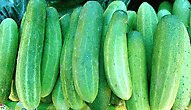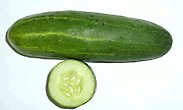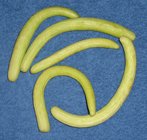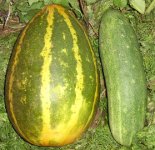In their New York Times bestseller The Okinawa Program, Drs. Bradley and Craig Willcox and Makoto Suzuki explained why the Okinawans are the longest-lived people on earth. Now, they offer a practical diet program rooted in Okinawan traditions so that you too can have a leaner, more “metabolically efficient” body that will stay healthier and more youthful. Conveniently divided into three dietary tracks—western, eastern, and a fusion plan that combines both—their program will help you achieve healthy weight loss without deprivation. With more than 150 recipes, an eight-week phase-in plan, and other unique resources, The Okinawa Diet Plan is an easy-to-follow breakthrough concept in healthy weight loss.
Okinawa diet is simple and close to the nature. It composes mainly of green/orange/yellow (GOY) vegetables, fruits, roots, and tubers and simple seafood. On an average, each Okinawan consumes no more than one calorie per gram of food and median BMI (Body Mass Index) is 20.
Goya chanpuru. Bitter melon slices stir-fried with tofu, onion and egg, in one of the Okinawa delicacies.
According to the reported news, a typical Okinawan may live on an average for 100 years of healthy, and productive life. Many theories postulated that the secret of centenarian lies in their genetic constitutional makeup. However, recent community research studies on Okinawa population suggest that the most important factor influencing their longevity is the simple food they consume; the knowledge handed over to them by their ancestors for centuries.
Yagisashi- thin slices of goat meat with lemon.

It is one of the oldest cultivated crops and believed to be originating in the northern sub-Himalayan plains of India. The plant is a creeper (vine) akin to other members of Cucurbita family such as gourds, squashes, melons, and zucchini.
Botanically; it belongs to the Cucurbitaceae family, and is known scientifically as Cucumis sativus.
Cucumber is easy to grow. Varieties, varying in size, shape, and color, are cultivated all around the world under different climatic zones. In general, the fruit features dark-green skin, crispy, moisture rich flesh, and small edible seeds concentrated near its core.
As in other squash members, cucumbers too are best harvested young, tender and just short of reaching maturity; at the stage when they taste sweet, have a crunchy texture, and almost neutral flavor. If left uninterrupted, the fruit continues to grow, its skin becomes tougher and turns yellow, and seeds become hard and inedible. Fresh cucumbers are available throughout the season and can be eaten raw, in vegetable salads or juicing.
Armenian cucumbers (Cucumis melo var. flexuosus) are long, crispy, thin-ribbed, curvy, and possess light green color. Although grouped botanically in the melon family, they appear and taste just like cucumbers.
Miniature varieties such as gherkins, American-dills, and French cornichons are tiny in size and usually preferred in pickling.
Dosakayi is a yellow Indian curry cucumber. It has mild sweet taste and neutral flavor. It is used extensively in the preparation of stews and curries, particularly during the summer season in southern parts of India and Sri Lanka.
Cucumbers can be sold readily in the local markets all around the season. Fresh varieties, depending upon the cultivar type and region, as well as preserved, pre-processed, and pickled are also made available in the grocery stores.
In the stores, buy fresh ones that feature bright green color, firm and stout in texture. Look for spots, cuts or breaks on its surface. Do not buy overly mature or yellow colored cucumber since they tend to possess tough skin, and mature (hard), inedible seeds. Furthermore, avoid those with wrinkled ends as they indicate of old stock and out of flavor. Go for organically grown products to get rich flavor and nutrient content.
Once at home, they should be washed thoroughly in clean water to rid off any surface dirt and pesticide residues. Their skin comes in a variety of colors and often with tiny spikes that should be rubbed off easily. Do not discard the peel as it has vital minerals, phytochemicals, and fiber.
To store, keep them at room temperature for a day or two, but better stored in the refrigerator set at high relative humidity where they stay fresh for several days.
Preparation and serving methods
Wash them thoroughly in cold running water just before use. Scrub gently at places where prickles or dirt attached firmly. Trim both ends using a sharp knife and rub the ends to remove sticky, off-white, fluid like oozing substance in order to lessen bitter taste at either end. Cut into cubes, slices, as you may desire.
Here are some serving tips:
Fresh, cleaned cucumbers may be enjoyed as they are without any additions.
Its cubes/slices are a great addition to vegetable/fruit salads.
Indian yellow curry-cucumber (dosakayi) is used widely in a variety of curry, and stew preparations in South India with added buttermilk and yogurt.
Finely chopped fresh slices mixed with yogurt, cumin, coriander, pepper, and salt to make Indian condiment, cucumber raita.
Cucumber juice is a very good health drink.
Fine slices also added in delicious Spanish cold tomato and cucumber soup, gazpacho.
Gherkins and thick rind of other varieties have been also used in the preparation of pickles.
A small slice of cucumber should be tasted before eating the whole fruit to ensure that it is not bitter. If found bitter; the whole fruit should be discarded. In a case of discomfort after consumption (nausea, vomiting, diarrhea or any feeling of uneasiness), the person should be immediately taken to any nearby hospital.
Okinawa diet is simple and close to the nature. It composes mainly of green/orange/yellow (GOY) vegetables, fruits, roots, and tubers and simple seafood. On an average, each Okinawan consumes no more than one calorie per gram of food and median BMI (Body Mass Index) is 20.
Goya chanpuru. Bitter melon slices stir-fried with tofu, onion and egg, in one of the Okinawa delicacies.
According to the reported news, a typical Okinawan may live on an average for 100 years of healthy, and productive life. Many theories postulated that the secret of centenarian lies in their genetic constitutional makeup. However, recent community research studies on Okinawa population suggest that the most important factor influencing their longevity is the simple food they consume; the knowledge handed over to them by their ancestors for centuries.
Yagisashi- thin slices of goat meat with lemon.
Salient features of Okinawa diet:-
- Calorie restricted diet: The diet of the Okinawan people is 20% lesser in calories than an average Japanese consumes. Their food is consistently averaging no more than one calorie per gram, and the average Okinawan has a BMI (Body Mass Index) of 20. Many research studies firmly suggest the human body receives more harmful free-radicals from food than they through the external agents like bacteria, viruses, chemicals, etc. Calorie restriction, therefore, thought to improve health and slow the aging process in some animal models like rodents by limiting their dietary energy intake below the daily average needs.
- Antioxidant-rich diet: Okinawa diet composes mainly green/orange/yellow (GOY) vegetables, fruits, roots, and tubers. These foods are rich sources of antioxidant vitamins like vitamin-C, vitamin-A, and flavonoid polyphenolic compounds like ß-carotenes, lutein, xanthins, and minerals like calcium, iron, potassium, and zinc.
- Low in fat and sugar: The Okinawa diet is low in fat, has only 25% of the sugar and 75% of the cereals of the average dietary intake of a Japanese. Limiting fat and sugar in the diet can help prevent coronary heart diseases and stroke risk.
- Vegetarian and seafood rich: The islander's traditional diet includes a relatively small amount of fish and somewhat more in the form of soy, low-calorie vegetables like bitter melon, and other legumes. Almost no meat, eggs, or dairy products are consumed. Fish provides omega-3 essential fatty acids like alpha-linolenic acid (ALA),eicosapentaenoic acid (EPA), and docosahexaenoic acid (DHA). Besides being an excellent source of protein, soy (in the form of tofu), contains health benefiting compounds like soluble dietary fiber, tannin antioxidants, and plant sterols. Altogether, these phytonutrients offer protection against heart diseases, stroke, colon, and prostate cancers.
- The "featherweight" foods: Food groups that provide less than or equal to 0.8 calories per gram belong to this category. Citrus fruits like orange, low-calorie vegetables like spinach, cucumber, etc. One can eat many servings per day without any reservations.
- The "lightweight" foods: Food items with a calorific density of 0.8 to 1.5 per gram fall in this category. Certain fruits like banana and vegetables like potato are examples in this category. One should consume these in moderation.
- The "middleweight" foods: Food group having a caloric density from 1.5 to 3.0 calories per gram, such as cereals like wheat, legume products, and lean meat included under this category. It advised that one should eat only while carefully monitoring the portion size.
- The "heavyweight" foods: Food items which provide 3 to 9 calories per gram (300 to 900 calories per 100 g) belong in this category. Many oils and fats, nuts, oil seeds and red meat fall in this category, which one should eat only sparingly.

Cucumber nutrition facts
Ever wonder how to beat the scorching summer heat? Just remember your backyard, humble crunchy cucumber! Nonetheless, this wonderful low-calorie vegetable indeed has more nutrients to offer than just water and electrolytes.It is one of the oldest cultivated crops and believed to be originating in the northern sub-Himalayan plains of India. The plant is a creeper (vine) akin to other members of Cucurbita family such as gourds, squashes, melons, and zucchini.
Botanically; it belongs to the Cucurbitaceae family, and is known scientifically as Cucumis sativus.
Cucumber is easy to grow. Varieties, varying in size, shape, and color, are cultivated all around the world under different climatic zones. In general, the fruit features dark-green skin, crispy, moisture rich flesh, and small edible seeds concentrated near its core.
 |
| Cucumber slice. |
As in other squash members, cucumbers too are best harvested young, tender and just short of reaching maturity; at the stage when they taste sweet, have a crunchy texture, and almost neutral flavor. If left uninterrupted, the fruit continues to grow, its skin becomes tougher and turns yellow, and seeds become hard and inedible. Fresh cucumbers are available throughout the season and can be eaten raw, in vegetable salads or juicing.
 |  |
| Cucumis melo var. flexuosus-Armenian type. | Dosakayi-Indian curry cucumber. Salad (slicing) cucumber by side for a comparison. |
Armenian cucumbers (Cucumis melo var. flexuosus) are long, crispy, thin-ribbed, curvy, and possess light green color. Although grouped botanically in the melon family, they appear and taste just like cucumbers.
Miniature varieties such as gherkins, American-dills, and French cornichons are tiny in size and usually preferred in pickling.
Dosakayi is a yellow Indian curry cucumber. It has mild sweet taste and neutral flavor. It is used extensively in the preparation of stews and curries, particularly during the summer season in southern parts of India and Sri Lanka.
Health Benefits of Cucumber
- It is one of the very low-calorie vegetables; provide just 15 calories per 100 g. It contains no saturated fats or cholesterol. Cucumber peel is a good source of dietary fiber that helps reduce constipation and offers some protection against colon cancers by eliminating toxic compounds from the gut.
- It is an excellent source of potassium, an important intracellular electrolyte. 100 g of cucumber provides 147 mg of potassium but only 2 mg of sodium. Potassium is a heart "friendly" electrolyte helps bring a reduction in total blood pressure and heart rates by countering effects of sodium.
- Cucumbers contains unique antioxidants in moderate ratios such as ß-carotene and α -carotene, vitamin-C, vitamin-A, zeaxanthin, and lutein. These compounds help act as protective scavengers against oxygen-derived free radicals and reactive oxygen species (ROS) that play a role in aging and various disease processes. Their total antioxidant strength, measured in terms of oxygen radical absorbance capacity (ORAC value), is 214 µmol TE/100 g.
- Cucumbers have mild diuretic property, which perhaps attributed to their free-water, and potassium and low sodium content. It helps in checking weight gain and high blood pressure.
- They surprisingly have a significant amount of vitamin-K, provides about 17 µg of this vitamin per 100 g. Vitamin-K has been found to have a potential role in bone strength by promoting osteoblastic (bone mass building) activity. It also has an established role in the treatment of Alzheimer's disease patients by limiting neuronal damage in their brain.
Cucumbers can be sold readily in the local markets all around the season. Fresh varieties, depending upon the cultivar type and region, as well as preserved, pre-processed, and pickled are also made available in the grocery stores.
In the stores, buy fresh ones that feature bright green color, firm and stout in texture. Look for spots, cuts or breaks on its surface. Do not buy overly mature or yellow colored cucumber since they tend to possess tough skin, and mature (hard), inedible seeds. Furthermore, avoid those with wrinkled ends as they indicate of old stock and out of flavor. Go for organically grown products to get rich flavor and nutrient content.
Once at home, they should be washed thoroughly in clean water to rid off any surface dirt and pesticide residues. Their skin comes in a variety of colors and often with tiny spikes that should be rubbed off easily. Do not discard the peel as it has vital minerals, phytochemicals, and fiber.
To store, keep them at room temperature for a day or two, but better stored in the refrigerator set at high relative humidity where they stay fresh for several days.
Preparation and serving methods
Wash them thoroughly in cold running water just before use. Scrub gently at places where prickles or dirt attached firmly. Trim both ends using a sharp knife and rub the ends to remove sticky, off-white, fluid like oozing substance in order to lessen bitter taste at either end. Cut into cubes, slices, as you may desire.
Here are some serving tips:
Fresh, cleaned cucumbers may be enjoyed as they are without any additions.
Safety profile
Often, some cucumbers mat turn bitter akin to bottle gourds due to terpenoid toxic compounds such as cucurbitacin B, D, G, H, etc.A small slice of cucumber should be tasted before eating the whole fruit to ensure that it is not bitter. If found bitter; the whole fruit should be discarded. In a case of discomfort after consumption (nausea, vomiting, diarrhea or any feeling of uneasiness), the person should be immediately taken to any nearby hospital.

No comments:
Post a Comment